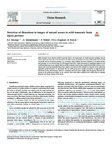Detection of distortions in images of natural scenes in mild traumatic brain injury patients
| dc.contributor.author | Jennings, BJ | |
| dc.contributor.author | KANG, JUNGHEE | |
| dc.contributor.author | Wehbé, F | |
| dc.contributor.author | Kingdom, FAA | |
| dc.contributor.author | Farivar, R | |
| dc.date.accessioned | 2019-06-17T18:38:34Z | |
| dc.date.issued | 2019-08 | |
| dc.identifier.issn | 0042-6989 | |
| dc.identifier.issn | 1878-5646 | |
| dc.identifier.uri | http://hdl.handle.net/10026.1/14324 | |
| dc.description.abstract |
Mild traumatic brain injuries (mTBI) frequently lead to the impairment of visual functions including blurred and/or distorted vision, due to the disruption of visual cortical mechanisms. Previous mTBI studies have focused on specific aspects of visual processing, e.g., stereopsis, using artificial, low-level, stimuli (e.g., Gaussian patches and gratings). In the current study we investigated high-level visual processing by employing images of real world natural scenes as our stimuli. Both an mTBI group and control group composed of healthy observers were tasked with detecting sinusoidal distortions added to the natural scene stimuli as a function of the distorting sinusoid's spatial frequency. It was found that the mTBI group were equally as sensitive to high frequency distortions as the control group. However, sensitivity decreased more rapidly with decreasing distortion frequency in the mTBI group relative to the controls. These data reflect a deficit in the mTBI group to spatially integrate over larger regions of the scene. | |
| dc.format.extent | 12-17 | |
| dc.format.medium | Print-Electronic | |
| dc.language | en | |
| dc.language.iso | en | |
| dc.publisher | Elsevier | |
| dc.subject | Mild traumatic brain injury (mTBI) | |
| dc.subject | Natural scenes | |
| dc.subject | Spatial distortions | |
| dc.title | Detection of distortions in images of natural scenes in mild traumatic brain injury patients | |
| dc.type | journal-article | |
| dc.type | Journal Article | |
| dc.type | Research Support, U.S. Gov't, Non-P.H.S. | |
| plymouth.author-url | https://www.webofscience.com/api/gateway?GWVersion=2&SrcApp=PARTNER_APP&SrcAuth=LinksAMR&KeyUT=WOS:000475411900002&DestLinkType=FullRecord&DestApp=ALL_WOS&UsrCustomerID=11bb513d99f797142bcfeffcc58ea008 | |
| plymouth.volume | 161 | |
| plymouth.publication-status | Published | |
| plymouth.journal | Vision Research | |
| dc.identifier.doi | 10.1016/j.visres.2019.05.004 | |
| plymouth.organisational-group | /Plymouth | |
| plymouth.organisational-group | /Plymouth/Faculty of Health | |
| plymouth.organisational-group | /Plymouth/REF 2021 Researchers by UoA | |
| plymouth.organisational-group | /Plymouth/REF 2021 Researchers by UoA/UoA03 Allied Health Professions, Dentistry, Nursing and Pharmacy | |
| plymouth.organisational-group | /Plymouth/Research Groups | |
| plymouth.organisational-group | /Plymouth/Research Groups/Institute of Health and Community | |
| plymouth.organisational-group | /Plymouth/Users by role | |
| plymouth.organisational-group | /Plymouth/Users by role/Academics | |
| dc.publisher.place | England | |
| dcterms.dateAccepted | 2019-05-12 | |
| dc.rights.embargodate | 2020-6-11 | |
| dc.identifier.eissn | 1878-5646 | |
| dc.rights.embargoperiod | Not known | |
| rioxxterms.versionofrecord | 10.1016/j.visres.2019.05.004 | |
| rioxxterms.licenseref.uri | http://www.rioxx.net/licenses/all-rights-reserved | |
| rioxxterms.licenseref.startdate | 2019-08 | |
| rioxxterms.type | Journal Article/Review |


